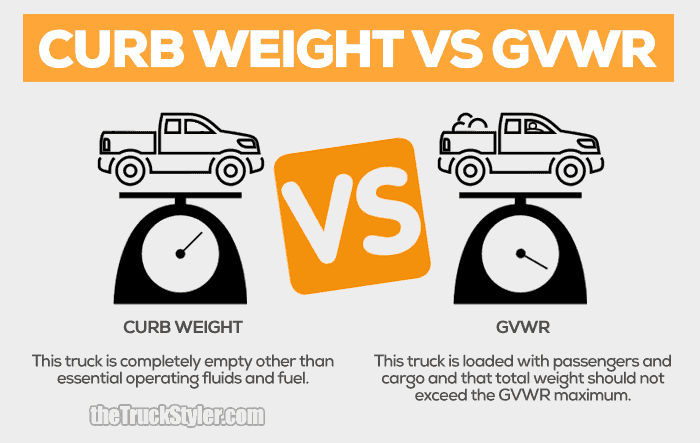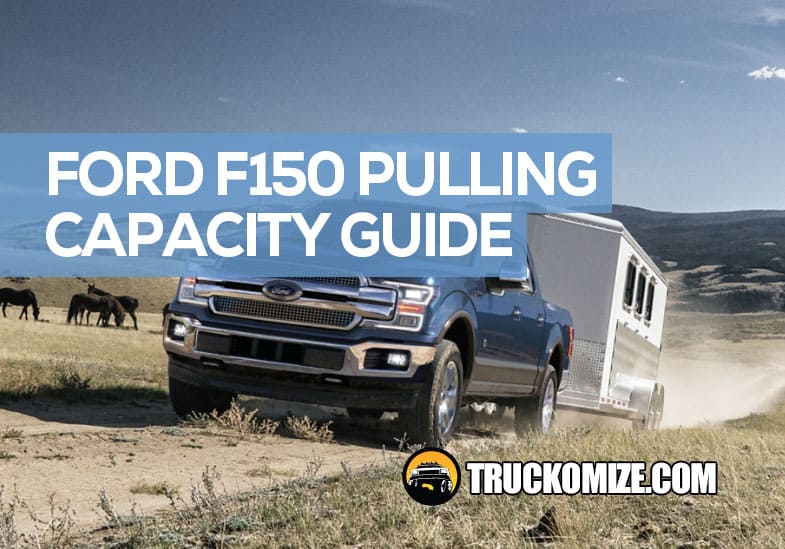Comparing pickup trucks can be a challenging task, especially when looking at manufacturer’s websites. Each one boasts that they have the toughest and strongest trucks. One thing they like to brag about is how much weight their latest models can pull. So, how does the Ford F150’s pulling capacity compare?
How much weight can a Ford F150 pull? When looking at a Ford F150, the towing capacity or pulling capacity of the truck depends on the size of engine. Here are some examples Ford F150 pulling capacities based on their engine size.
F150 pulling capacity (year by year examples)
- 2020 F150 2.7L Turbo EcoBoost: Pulling capacity of 8,500 pounds
- 2020 F150 3.5L EcoBoost: Pulling capacity of 13,200 pounds
- 2020 F150 3.3L Ti-VCT V6: Pulling capacity of 7,700 pounds
- 2020 F150 5.0L Ti-VCT V8: Pulling capacity of 11,600 pounds
- 2020 F150 3.0L PowerStroke Turbo Diesel: Pulling capacity of 11,500 pounds
- 2019 F150 2.7L Turbocharged EcoBoost: Pulling capacity of 9,000 pounds
- 2019 F150 3.0L Power Stroke Turbo Diesel: Pulling capacity of 11,500 pounds
- 2019 F150 3.3L TI-VCT V6: Pulling capacity of 7,700 pounds
- 2019 F150 3.5L EcoBoost: Pulling capacity of 13,200 pounds
- 2019 F150 High-Output 3.5L EcoBoost: Pulling capacity of 11,100 pounds
- 2019 F150 5.0L TI-VCT V8: Pulling capacity of 11,500 pounds
- 2018 F150 2.7L EcoBoost V6: Pulling capacity of 9,000 pounds
- 2018 F150 3.0L Power Stroke Turbo Diesel: Pulling capacity of 11,500 pounds
- 2018 F150 3.3L TI-VCT V6: Pulling capacity of 7,700 pounds
- 2018 F150 3.5L EcoBoost V6: Pulling capacity of 13200 pounds
- 2018 F150 3.5L EcoBoost H.O V6: Pulling capacity of 8,000 pounds
- 2018 F150 5.0L TI-VCT V8: Pulling capacity of 11,600 pounds
- 2017 F150 5.0L EcoBoost V8: Pulling capacity of 11,000 pounds
- 2017 F150 3.5L EcoBoost V6: Pulling capacity of 12,200 pounds
- 2017 F150 XL 3.5L V6: Pulling capacity of 5,000 pounds
- 2016 F150 3.5L Ti-VCT V6: Pulling capacity of 5,000 pounds
- 2016 F150 3.5L GTDI V6: Pulling capacity of 12,200 pounds
- 2016 F150 2.7L EcoBoost V6: Pulling capacity of 8,500 pounds
- 2016 F150 5.0L Ti-VCT V8: Pulling capacity of 11,100 pounds
- 2015 F150 3.5L: Pulling capacity of 7,600 pounds
- 2015 F150 2.7L EcoBoost: Pulling capacity of 8,500 pounds
- 2015 F150 3.5L EcoBoost: Pulling capacity of 12,200 pounds
- 2015 F150 5.0L: Pulling capacity of 11,100 pounds
- 2014 F150 3.7L XL 2WD V6: Pulling capacity of 11,300 pounds
- 2014 F150 Lariat Extended Cab 2WD: Pulling capacity of 11,300 pounds
- 2014 F150 King Ranch 2WD: Pulling capacity of 11,300 pounds
- 2014 F150 SBVT Raptor Extended Cab 4WD: Pulling capacity of 6,000 pounds
With all of the spec sheets available online, it can make it challenging to comprehend all of the information. The technical terms can be overwhelming because it seems to have a different name for the same thing, just in a different part of the truck.
That is why I created this guide to let you know everything you need to know about how much weight the Ford F150 can pull and its towing capacity.
More on the Ford F150 towing capacity
The Ford F150 has a maximum towing capacity of 13,200 pounds when using the V6 EcoBoost engine. The maximum payload is only 3,040 pounds. The payload is what fits directly into the bed of the F150 pickup. Anything more substantial than that would need to be placed in a trailer.
There are a few terminologies to get out of the way before continuing.
The first one is Gross Vehicle Weight Rating (GVWR). This is the weight of the truck plus any passengers or luggage (it’s not the same as towing capacity). The GVWR takes into consideration the vehicle without the trailer attached.
Manufacturers must consider the suspension and weight distribution of the engine placement and other components. GVWR is also vehicle-specific, which includes any type of trailer.
GVWR on a trailer is the maximum weight that the trailer can weigh with cargo.
Gross Combined Weight Rating, or GCWR on most labels, is the maximum weight of your truck with the trailer attached and loaded. You can read here what the differences between GVWR and GCWR are.
The gross axle weight is the maximum weight that can be placed on both axels, the front and rear ratings are based on the amount of weight the axles can handle before breaking. It is incredibly unsafe to overload the axles of the vehicle.
Some of the statistics of the maximum tow package on a 2018 Ford F150 for example, are:
- 375 hp
- 470 lb-feet of torque best in class
- Max Towing 12,700 pounds
- Max Payload 2,030 pounds
- Axle Ratio 3.55
- GVWR 7,000 pounds
- GCWR 18,100 pounds
What weight can an F150 pull?
Depending on the engine size and axle ratio that you choose, the F150 can tow anywhere from 7,700 pounds. to 13,200 pounds. It comes down to more than just a final weight. The load must also be balanced in order for the truck to function correctly.
The axle weight is one of the more critical measurements that nobody talks about. You can generally put more pressure on the rear axles than the front. The front axles are already supporting a lot of weight with the engine and the majority of the cab.
The owner’s manual for the F150 you own will have that information. You can also download a copy from the Ford website.
Considering that the F150 can pull a total Gross Combined Vehicle weight of 13,200 punds, we must also consider the vehicle weight itself in that combination. The curb weight is what the F150 weighs with nothing in it and must be subtracted from the Gross Combined Vehicle weight (again, curb weight and GVWR are two distinct things).

The Ford F150 has a curb weight of 4,069 pounds, for the 2×4 and the 4,330 pounds for the 4-wheel drive.
Curb weight counts against the 13,200 pounds of Ford F150 pulling capacity, so we are down to 9,131 pounds roughly. This measurement only takes into account the F150 with nothing but the required fluids in it to run.
Can an F150 pull a horse trailer?
An average 2-horse horse trailer weighs between 2,400 and 3,200 pounds when sat empty. The average horse weighs anywhere from 840 to 2,200 pounds. The weight of food and water for the horse must also be considered and the hay.
During the course of the trip, the horse is likely going to pass a stool or two, so considering the weight of the horse stools we can add a hundred pounds for every 500 miles. The tongue weight is the amount of force pushing down on the back of the vehicle, which is affected by the way the cargo is positioned. You will need a trailer tongue gauge to measure this weight.
To determine whether a Ford F150 can pull a horse trailer, we first need to know the type of F150 that we have. The 3.3-liter base, for example, has a max towing capacity of 7,700 pounds, after subtracting the curb weight (4,069 pounds) we can have a maximum trailer load of 3,631 pounds.
If you are taking the lightest horse trailer at 2,400 pounds. That leaves 1,231 pounds for the payload and cargo. If you have only one small horse and minimal load, then the F150 base could pull this horse trailer.
It breaks down like this:
- Max weight: 7,700 pounds.
- Curb Weight: 4069 pounds.
- Trailer weight: 1231 pounds.
- Horse weight: 1000 pounds.
- Hay weight: 60 pounds.
- Water weight: 110 pounds.
- Horse stool weight: 100 pounds.
- 1 x driver weight: 250 pounds.
- 1 x suitcase / baggage weight: 60 pounds.
- Any additional gear weight: 150 pounds.
- Total: 670 pounds remaining.
You can use this basic arithmetic to figure out how much weight any Ford F150 can pull, no matter what the engine size. Just switch the values out.
Can an F150 pull the 5th wheel?
The fifth wheel connection is a type of connector that has a U-shape in the back of your F150. It limits the payload capabilities, as the 5th wheel trailer hitch is usually in the back of the truck. The trade off: better control and better gas mileage of the truck.
The weight of the fifth wheel trailer will depend on the container itself. There are all sorts of 5th wheel trailers on the market. You can get some as small as 2400 pounds all the way up to 20,000 pounds. The concept is the same as above, using the same chart, you would just need some different elements.
All things considered, the 5th wheel would give a little added control to the stability of the drive. You will need to consider the amount of stuff in the back of your F150 truck. Balancing the load is also part of the trip, and sometimes you may need to leave a suitcase or a tent in the trailer instead of the cab or the truck bed.
You also need to make sure that you connect the 5th wheel correctly, here is a neat video that shows how to hook them up to your truck.
Can an F150 pull a travel trailer?
A camper has two different weights when looking at them, the dry weight and the GVWR, or Gross Vehicle Weight Rating. The dry weight means the weight of the camper with no equipment or fluids in it. This makes for complicated setup, but it is straightforward, really.
You have the difference between the dry weight and the GVWR to load the trailer with your belongings. The GVWR is the maximum load the trailer can carry with the dry weight. You want to bet on adding about 1500 pounds to the dry weight with everything loaded.
One gallon of water at room temperature weighs 8.345 pounds. If you fill up your 50-gallon freshwater tank, you are adding 417.25 pounds to the trailer. A good generator will weigh about 90 pounds; then, you must combine any food, blankets, dishes, and other belongings.
You can weigh the camper at most cat scales across the country. You can find one in your area here.
Now we are looking at a total weight of around 6,700 pounds. We know that the base model Ford F150 with the 3.3 liter can only pull a total of 7,700 pounds minus the curb weight. To figure this problem out, let us take the total weight and add the curb weight of the F150 to see which model we would need.
5,200 pounds (dry weight) + 1,500 pounds (supplies) + 4,069 pounds (curb weight of the Ford) = 10,769 pounds: Therefore, you would need an F150 v8 or 3.0 diesel motor to haul a camper.
Can an F150 pull a car trailer?
The car trailer at most weigh 2,000 pounds; then, you must add the weight of the car to the trailer. The curb weight of the vehicle is what you add to the weight of the trailer. The trailer will have its own GVWR rating. You can then subtract the weight of the trailer from the GVWR to determine how heavy of a load the trailer can handle.
The place in which the vehicle is parked on the back of the trailer will affect the axle weight and the tongue weight of the load. You want the tongue weight no lighter than 9% and no heavier than 15% of the gross trailer weight. You must adjust the pressure properly to drive the trailer safely.
Don’t forget to add in any extra weight that you may have as well. If you build your own sidewalls for your car trailer, then you must subtract that weight from the GVWR as well. The tow straps may only weigh a few pounds but remember to throw that weight in there as well.
In short, the F150 base model is not going to be able to handle a regular four-door sedan on the back of a car trailer. Let us break this down to make sure:
7700 max tow weight
- 4069 pounds curb weight of the F150
- 1600 pounds curb weight of the car trailer (16-inch trailer)
- 4,000 pounds curb weight of the car itself
- 250 pounds person
- 100 additional equipment
- = (2,319) in the negative
It looks like we would have to go up to the F150 V8 model to pull your average car. You can find your vehicle’s weight on the VIN tag on the Inside of the driver’s side door on your car.
Can an F150 pull a tent camp trailer?
Tent campers can weigh anywhere from 600 to 4,500 pounds. The average weight is about 2,000 pounds. These pop-up tent trailers can be a fun little camper, and some of them can even be pulled with a car. There are several different weights to consider when thinking about the tent camper trailer.
The UVW is the unloaded vehicle weight similar to the dry weight of a travel trailer. CCC is the cargo-carrying capacity, which is all of your belongings. It is a good idea to weigh everything with a scale before loading it into the tent camper. You want to stay below your CCC for safety reasons.
You can use a standard bathroom scale to weigh the goods before loading them.
These trailers have another essential weight rating, which is the GAWR, or Gross Axle Weight Rating. Overloading the GAWR can cause the tent trailer to not transport correctly and may even damage the trailer.
Any of the F150 models should be able to tow a pop-up tent as long as the GVWR is lower than the towing capacity of the F150. Remember that this is fully loaded and includes the trailer hitch weight as well. If the GVWR of the pop-up tent trailer is lower than the maximum towing capacity minus the curb weight of the truck, then it will tow it.
This video has 13 tips and tricks for pop up tents.
Can an F150 pull a dump trailer?
Dump trailers are a whole different animal altogether, but the concept is the same. The main difference is the payload rating for the dump trailer.
Dump trailers will have different weight grades, based on the number of axles, and features of the container itself. Every trailer will have a GVWR, and the safe way is to never let the GVWR exceed the pulling capacity of the F150.
You will not be able to use a base model even for the lightest of dump trailers. You can probably get away with the 2.7 EcoBoost model, but you’re pushing your luck. The recommended model would be the V8 at a minimum. You want the 11,500 pounds tow capacity.
The 50SR single axle trailer is a small, lightweight dump trailer that weighs only 1,680 pounds and has a payload capacity of 3,320 pounds. With this trailer fully loaded, the minimum requirements would only be met with the V8 model. If you have any accessories on the trailer, this adds to the trailer weight.
Can an F150 pull a pontoon boat
You can’t pull a pontoon without a boat trailer. A pontoon boat trailer, on average, will weigh 2,000 pounds. A pontoon boat that is empty will weigh around 2,200 pounds on average. After you add gear, you want to estimate about another 1,500 pounds. A pontoon boat with the trailer will weigh approximately 5,700 pounds.
You want to stay under your F150’s towing capacity, and remember to subtract the curb weight from the towing capability. We can use some reverse formulas to figure out which model would work the best with the average pontoon boat. Adding the curb weight of the truck to the 5,700 pounds would be the minimum tow capacity we would need.
After adding everything up, we would need to stick with the V8 models and higher. The V8 engine models will tow 11,500 pounds, including the curb weight of the F150. That model or higher would pull this pontoon with no issues at all.
2,000 pounds (pontoon trailer) + 2,200 pounds (Pontoon of 100 pounds per foot of boat) + 1,500 pounds for gear = 5,700: Therefore: 700 pounds + 4,069 pounds (curb weight of F150) = 9,769 pounds advertised tow capacity.
Conclusion
The Ford F150 is a beast of a truck. By adding in the 4×4 capability, it’s almost the only vehicle you would want for your towing needs as this will increase your Ford F150’s pulling capacity significantly. Comparing the F150 to the Chevy Silverado, the F150 wins in towing capacity every time.
For an exact measurement on how much weight you Ford F150 can pull, please talk with your dealer.
You might also like…
Here are some more guides on the popular Ford F150:


